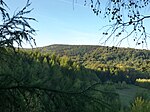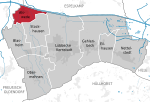Obermehnen
Detmold region geography stubsLübbeckeWiehen Hills

Obermehnen is a village in the German state of North Rhine-Westphalia in the county of Minden-Lübbecke. The village belongs administratively to the town of Lübbecke. Obermehnen has 1,360 inhabitants and an area of 9.6 km². At around 137 people per km² Obermehnen has the lowest density of all of Lübbeck's districts, not least because 4.3 km², i.e. 45%, of the parish area consists of uninhabited hill forest on the Wiehen Hills. Obermehnen is thus the most wooded part of the borough of Lübbecke.
Excerpt from the Wikipedia article Obermehnen (License: CC BY-SA 3.0, Authors, Images).Obermehnen
Mehner Mühle,
Geographical coordinates (GPS) Address Nearby Places Show on map
Geographical coordinates (GPS)
| Latitude | Longitude |
|---|---|
| N 52.285487 ° | E 8.577747 ° |
Address
Mehner Mühle
32312 , Obermehnen
North Rhine-Westphalia, Germany
Open on Google Maps








